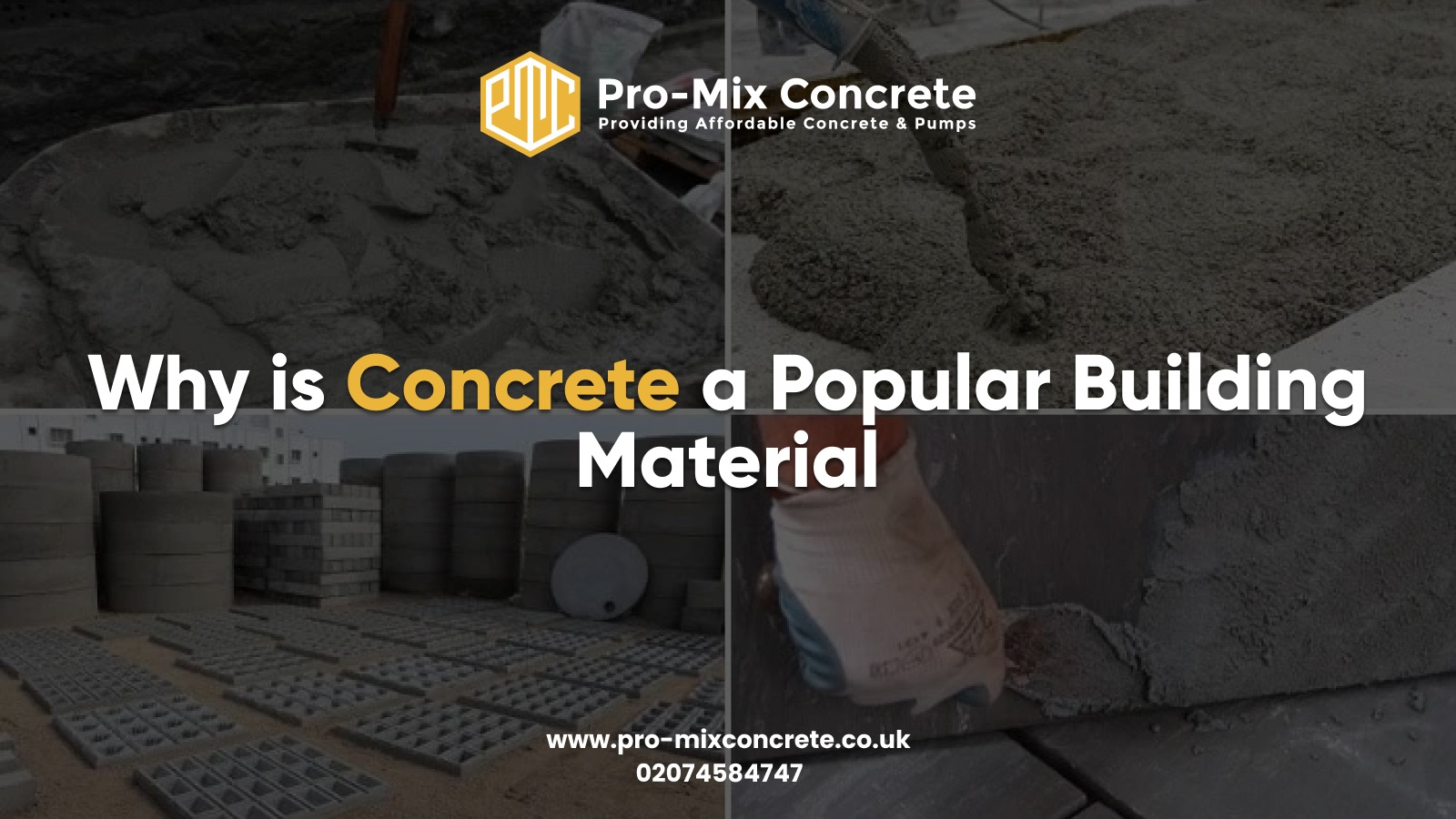certain building materials have stood the test of time while others have fallen by the wayside. Among these enduring champions, concrete reigns supreme as perhaps the most versatile and widely used building material in human history. Why is concrete so popular across the globe? The answer lies in its remarkable combination of strength, versatility, and cost-effectiveness.
As the fundamental backbone of modern infrastructure, concrete combines simple ingredients—cement, water, and aggregates such as sand and gravel—into a substance capable of supporting massive structures and withstanding extreme conditions.
5 Reasons Why Concrete a Popular Building Materials
1. Strength
C40 Concrete mix has earned its reputation as the most robust construction material due to its impressive strength characteristics. It can withstand immense weight and pressure without failing, making it ideal for structural applications.
What makes concrete’s strength so remarkable:
- The strength can be customized by adjusting the water, cement, and aggregate ratio
- Cement reacts with water to form a binding paste that hardens over time
- Concrete continues to strengthen for years after initial construction
- Suitable for everything from residential homes to massive infrastructure projects
Despite its strength, environmental factors can affect concrete’s performance. For instance, when asked “Will concrete set in the rain?” – yes, it will, but rainwater can dilute the mixture and potentially compromise stability and durability. This highlights the importance of considering weather conditions during construction.
Learn: how I calculate cement bags for concrete of different grades.
2. Durability
When it comes to withstanding the test of time, there’s no building material that can match concrete’s exceptional resilience. This remarkable durability stems from concrete’s unique composition and physical properties.
Modern structures face countless threats – from environmental forces to everyday wear and tear. Concrete meets these challenges with impressive resistance:
- Weather resistance: Concrete withstands harsh climate conditions including freezing temperatures, extreme heat, and driving rain without degrading
- Pest immunity: Unlike wooden structures that fall victim to termites and other insects, concrete remains completely impervious to pest damage
- Fire protection: During fires, concrete maintains structural integrity far longer than steel or wood, providing crucial time for evacuations
- Water damage resistance: Properly sealed concrete repels water rather than absorbing it, preventing internal damage from moisture
Historical evidence of concrete’s longevity is everywhere. The ancient Romans perfected their concrete formula over 2,000 years ago, creating structures like the Pantheon that still stand today. Modern engineering has only improved upon these time-tested techniques, extending concrete’s potential lifespan even further.
This exceptional durability translates to practical benefits for property owners. Concrete structures require minimal maintenance compared to alternatives, reducing lifetime ownership costs substantially. While wooden elements may need replacement and steel components demand anti-corrosion treatments, concrete continues performing year after year with minimal intervention.
-
Reflectivity
Concrete’s ability to reflect heat rather than absorb it is one of its most valuable yet underappreciated qualities. While darker materials like asphalt trap heat, concrete’s lighter surface bounces solar radiation away from buildings and urban areas.
Temperature regulation benefits:
- Reduces interior building temperatures by up to 10°F compared to asphalt-surrounded structures
- Decreases air conditioning usage, lowering energy bills during summer months
- Minimizes the carbon footprint associated with cooling systems
- Creates more comfortable outdoor spaces in urban environments
This reflective property makes concrete particularly valuable in hot climates. Cities in regions with high temperatures can experience significant cooling effects by incorporating more concrete into their infrastructure planning.
Urban heat island mitigation:
- Helps counteract the “heat island effect” that raises temperatures in densely built areas
- Reflects rather than absorbs solar radiation, cooling surrounding air temperatures
- Reduces heat-related health risks for urban residents
- Decreases the need for energy-intensive cooling in metropolitan areas
Beyond temperature control, concrete’s reflectivity serves another important function – enhancing visibility and safety. Its bright surface makes it ideal for applications where visibility is crucial.
4. Economical Benefits
When evaluating some building material, both initial and lifetime costs must be considered. Concrete offers an excellent balance of upfront affordability and long-term value.
Concrete provides economic advantages through:
- Reduced operational energy requirements, which typically account for 85% of a building’s lifetime energy consumption
- Minimal maintenance, repair, and replacement needs
- Life cycle savings that can exceed 20% of total construction costs
- Excellent insulating properties that lower heating and cooling expenses
- Thermal mass that provides passive temperature regulation
Concrete’s thermal mass is particularly valuable as an economic feature. By absorbing, storing, and releasing heat, concrete buildings can harvest natural energy sources like sunlight and reduce dependence on mechanical climate control systems.
The passive regulation helps maintain comfortable interior conditions while minimizing energy costs. As any reliable building materials supplier will confirm, the long-term cost savings of concrete often outweigh initial investments.
- Safety
Safety is perhaps concrete’s most important benefit, especially for buildings where human life and valuable assets need protection.
Concrete enhances safety through:
- Non-combustibility and resistance to high temperatures
- Resistance to moisture damage, rot, and mildew
- Excellent indoor air quality with no volatile organic compounds (VOCs)
- Superior structural integrity during extreme weather events
- Enhanced resistance to earthquakes and hurricanes when properly reinforced
Building codes in areas prone to natural disasters often require reinforced concrete specifically because of these safety attributes. The material’s strength and durability provide peace of mind, knowing that a structure will remain standing and protect its occupants even under challenging conditions.
Final Thoughts
It’s clear that concrete is a favourite construction material that provides numerous benefits for construction projects. If you’re looking for a reliable and high-quality supplier of concrete in London UK, Pro Mix Concrete is just what you are looking for. With years of experience and a commitment to providing exceptional customer service, we are a reliable building materials supplier trusted by contractors and DIY enthusiasts alike.
Frequently Asked Questions
Concrete’s popularity stems from its unbeatable combination of strength, versatility, durability, and cost-effectiveness. It can be formed into virtually any shape, provides exceptional structural integrity, and offers long-term value through reduced maintenance costs.
Yes! Modern concrete techniques include stamping, staining, polishing, and texturing that create beautiful finishes. Concrete can mimic natural stone, brick, wood, or tile while maintaining its durability. Many designers now feature exposed concrete as a design element rather than covering it.
Concrete excels in extreme weather. With proper additives, it withstands freezing temperatures and freeze-thaw cycles. It remains stable in high heat without softening like asphalt. In hurricane-prone areas, reinforced concrete offers superior wind resistance compared to most alternatives.
Recent innovations include self-healing concrete containing limestone-producing bacteria, ultra-high-performance concrete with exceptional strength, pervious concrete for better stormwater management, and carbon-sequestering concrete that absorbs CO2 as it cures.
Author
- Dennis Broderick
- Dennis Broderick is the founder and owner of Pro-Mix Concrete Company, a trusted name in ready-mix concrete solutions across the UK. With over 20 years of hands-on experience in the construction and concrete industry, Dennis brings unmatched expertise, practical insights, and a commitment to quality on every project - from residential driveways to large-scale commercial developments.
Latest entries
BlogJuly 15, 2025Why Same-Day Concrete Delivery is Vital for Small Builders in London?
BlogJuly 10, 2025Concrete vs. Screed: Which is Best for Your Project?
BlogJuly 5, 20255 Mistakes to Avoid When Ordering Ready Mix Concrete in London
BlogJune 27, 2025How Same-Day Concrete Delivery Works in the UK?




